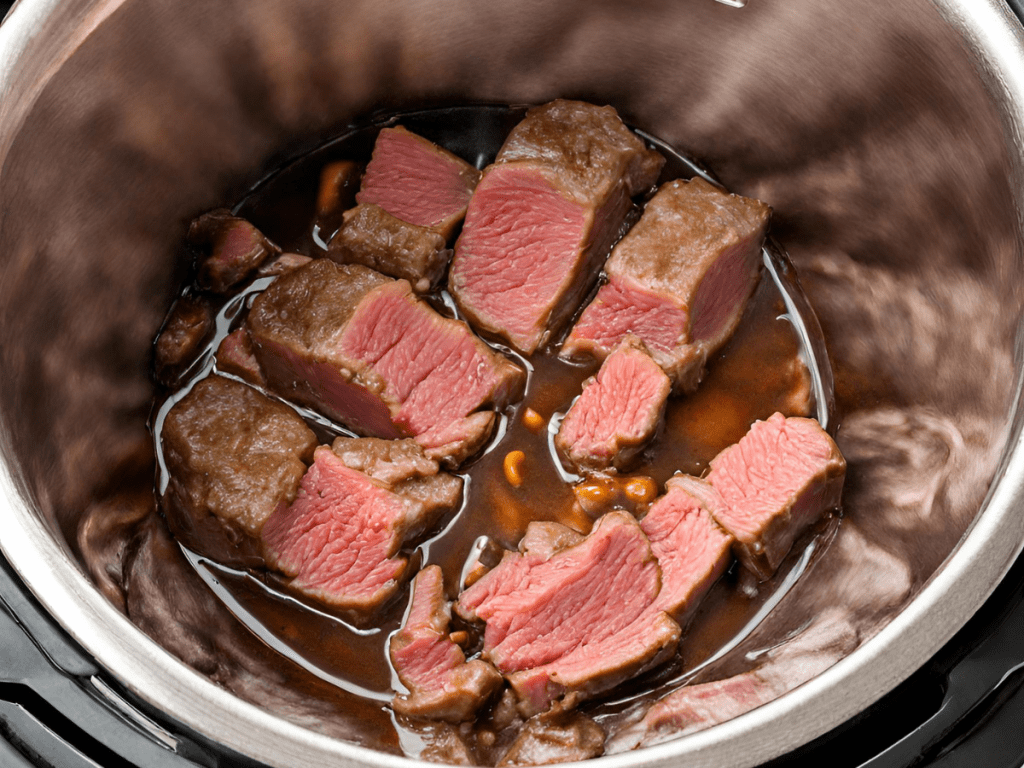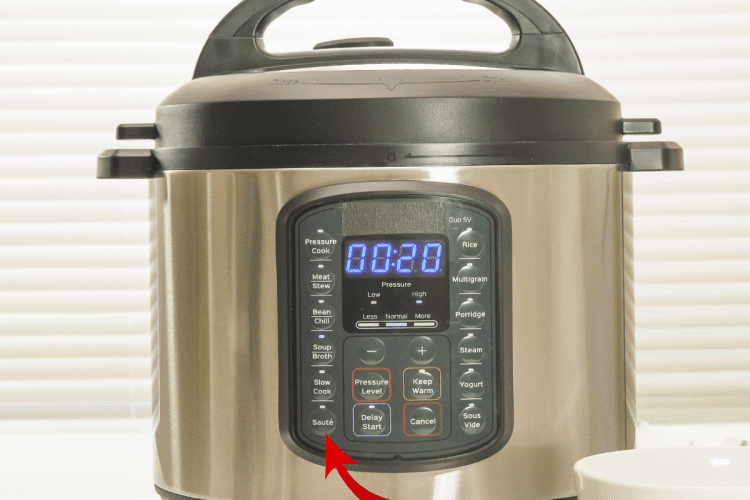Sautéing is a fundamental cooking technique used to enhance the flavors in your dishes. Whether you’re a seasoned home chef or a beginner in the world of cooking, mastering sautéing in your Instant Pot is essential for creating delicious meals. In this comprehensive guide, we’ll explore the art of sautéing in your Instant Pot, step by step, to help you elevate your cooking skills.
When to Use the Sauté Button on Your Instant Pot
The sauté function on the Instant Pot is a versatile feature that allows you to brown, sear, and sauté ingredients directly in the cooking pot before pressure cooking or using other cooking functions. Three of the main uses for sauté mode in the Instant Pot are:
Browning Meats

Sauté mode allows you to brown meats before pressure cooking or using other cooking functions. This step enhances the flavor and texture of dishes like stews, chilis, and braised meats. It’s a crucial step for creating rich, savory flavors.
Sautéing Aromatics

You can use sauté mode to cook and sauté aromatic ingredients such as onions, garlic, and spices. Sautéing these aromatics in oil or butter at the beginning of a recipe helps release their flavors and build a solid foundation for your dishes.
Reducing Sauces and Liquids

Sauté mode can be used to reduce the liquid content in your recipes, allowing you to thicken sauces, gravies, and soups. By simmering on sauté, you can achieve the desired consistency and concentration of flavors in your dishes.
Does the Instant Pot Sauté as Well as a Pan on the Stove
Both methods have their merits:
Instant Pot
- Consistent heat: No more hot spots or uneven cooking!
- Fewer dishes: One pot to sauté and cook is a win for convenience and cleanup.
- Built-in timer: Walk away and let the Instant Pot do the work while you prep other ingredients.
Stovetop pan
- Direct heat control: Fine-tune the heat instantly for delicate tasks or achieving a specific sear.
- Lighter, more maneuverable: Easier to toss and stir ingredients or adjust cooking for individual pieces.
Why Sautéing in Your Instant Pot
Sautéing in your Instant Pot is a culinary game-changer, offering a host of benefits that elevate your cooking experience. This method is not merely about preparing ingredients; it’s a flavorful journey that enhances the taste and texture of your dishes. The sauté function allows you to build intricate flavor profiles by browning and caramelizing ingredients, creating a foundation that transforms ordinary meals into extraordinary culinary creations.
Whether you’re searing proteins to perfection, infusing aromatics, or locking in succulent juices, sautéing in the Instant Pot is a versatile technique that adapts to a myriad of recipes. Beyond its flavor-enhancing capabilities, the sauté function streamlines your cooking process, providing a convenient one-pot solution that saves time and minimizes cleanup. The consistent results, temperature control, and adaptability make sautéing in your Instant Pot an indispensable step towards achieving delicious, well-rounded meals with ease.
How To Use Sauté In Instant Pot

Sautéing in an Instant Pot is a fantastic way to elevate the flavors of your dishes by adding depth and complexity. Here’s a step-by-step guide on how to sauté in an Instant Pot:
Preparation:
Start by gathering and preparing all your ingredients. Chop vegetables, season your protein, and have your herbs and spices ready.
Preheat the Instant Pot:
- Turn on the Instant Pot and select the Sauté function. Adjust the heat level using the Less/Normal/More mode according to your recipe or preference.
- Add a tablespoon of cooking oil (olive oil, for instance) to the Instant Pot. Allow it to heat up.
Searing Proteins:
Place your protein into the Instant Pot. It could be diced chicken, beef cubes, or tofu. Sear the protein on all sides until it develops a golden-brown crust. This step locks in flavors and enhances the overall taste.
Adding Aromatics and Vegetables:
- Introduce aromatic herbs and spices to the pot. This could include garlic, onions, cumin, or any other spices your recipe calls for.
- Add your chopped vegetables and stir occasionally. Sauté them until they begin to soften and develop color.
Deglazing the Pot:
If you notice any bits sticking to the bottom of the pot, don’t worry. Deglaze the pot by adding a splash of liquid—broth, wine, or water—and scrape off the flavorful bits with your spoon. This adds depth to your dish.
How To Adjust the Temperature Settings On The Sauté Function
The sauté function on your Instant Pot has three different temperature settings: Less, Normal, and More. You can change the temperature by pressing the Adjust button after pressing the Sauté button. The display will show the selected temperature setting.
Here’s a quick guide on what each temperature setting means and when to use it:
- Less: This is the lowest temperature setting, equivalent to low heat on a stovetop. Use this setting for simmering, reducing, or keeping food warm.
- Normal: This is the default temperature setting, equivalent to medium heat on a stovetop. Use this setting for most sautéing tasks, such as browning meat, softening vegetables, or making sauces.
- More: This is the highest temperature setting, equivalent to high heat on a stovetop. Use this setting for searing, caramelizing, or frying.
Tips and Tricks For Using The Sauté Function On Your Instant Pot
Here are some additional tips and tricks to help you use the sauté function on your Instant Pot effectively and safely:
- Always use enough oil or butter to prevent your food from sticking to the bottom of the pot. You can also use cooking spray, broth, or water to prevent sticking, but be careful not to add too much liquid, as this can affect the pressure cooking process.
- Don’t overcrowd the pot when sautéing, as this can lower the temperature and prevent even browning. Work in batches if necessary, and transfer the cooked food to a plate or a bowl until you are ready to add it back to the pot.
- Deglaze the pot after sautéing, especially if you are going to pressure cook afterwards. This means adding a small amount of liquid, such as water, broth, wine, or vinegar, and scraping up the browned bits from the bottom of the pot. This will prevent the burn notice from appearing, and also add more flavor to your dish.
- Use the glass lid or a compatible lid to cover the pot when sautéing, if you want to prevent splatter, speed up the cooking, or retain moisture. Don’t use the pressure cooking lid, as this can create pressure and cause safety issues.
- Clean the inner pot and the lid after using the sauté function, as the oil and food residue can affect the sealing and the performance of your Instant Pot. You can wash them by hand or in the dishwasher, or use the steam cleaning function on your Instant Pot.
FAQs
How do I activate the sauté mode Instant Pot?
Press the “Sauté” button on your Instant Pot to activate the mode. Adjust the heat level using the Less/Normal/More options if available
Why is sautéing important in an Instant Pot?
Sautéing in an Instant Pot is crucial for flavor development. It allows you to brown proteins, caramelize vegetables, and build a rich foundation for your dishes, enhancing taste and texture.
Can I sauté without oil in my Instant Pot?
While it’s generally recommended to add oil for sautéing, exceptions exist. If you’re browning fatty meats like ground beef, the fat released during cooking can suffice, and additional oil may not be necessary.
Can I adjust the heat level during sauté mode on my Instant Pot?
Yes, Instant Pot sauté mode often comes with adjustable heat settings like Less, Normal, and More. You can choose the appropriate setting based on your recipe and preferences.
Do you sauté with the lid on?
You should never put the Instant Pot lid on when using sauté.
When should I use the sauté function on my Instant Pot?
Use the sauté function when you want to sear proteins, caramelize vegetables, or create a flavorful base before pressure cooking. It’s a versatile feature that adds depth to various recipes.
Why is sautéing important in an Instant Pot?
Sautéing in an Instant Pot is crucial for flavor development. It allows you to brown proteins, caramelize vegetables, and build a rich foundation for your dishes, enhancing taste and texture.
